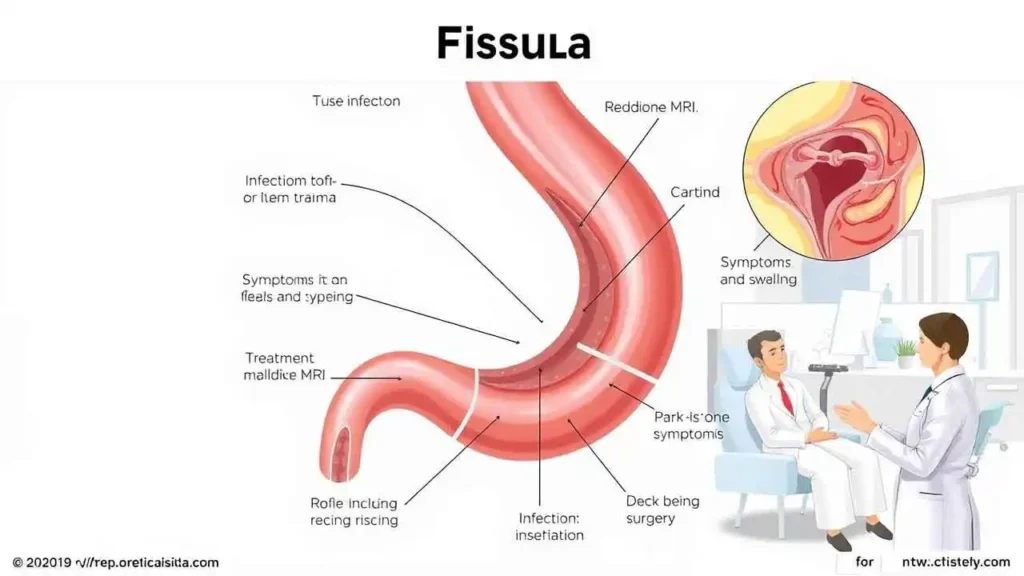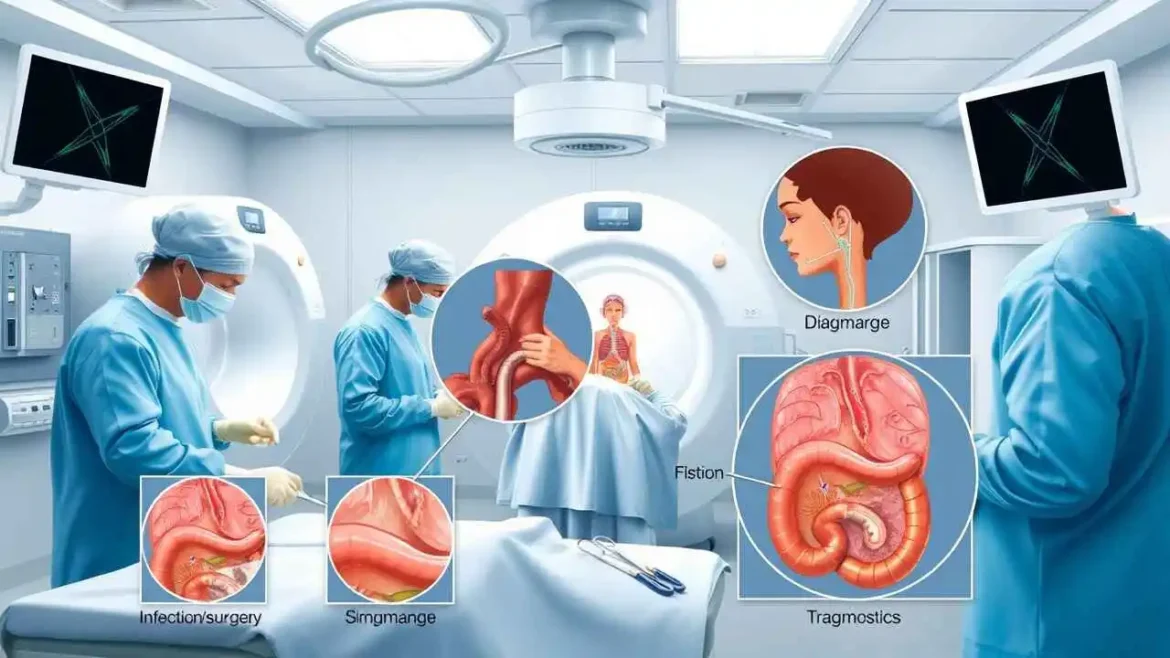
Understanding Fistulas: Exploring Causes, Symptoms, Diagnosis, and Treatment
We often navigate the complex landscape of our bodies, rarely giving thought to the intricate network of passages and connections that allow us to function. However, sometimes, abnormal connections form, creating challenges we must address. One such challenge is brought about by what we call a fistula – an unwanted pathway that disrupts normal anatomy and function. Understanding what a fistula is, why it occurs, how it manifests, and how we approach its resolution is crucial for anyone affected or seeking knowledge.
What Exactly is a Fistula? We Define the Abnormal Passage
At its core, a fistula is an abnormal, tunnel-like connection that develops between two organs, vessels, or tubes that don’t normally connect, or between one of these structures and the outside surface of the body. Think of it as an unscheduled detour that allows fluids, waste, or other substances to travel along a path they aren’t meant to take.
These unwanted passages can form in many different parts of the body. Some of the more commonly discussed types include:
- Anal Fistula: Connecting the anal canal or rectum to the skin near the anus.
- Enterocutaneous Fistula: Connecting the intestine to the skin.
- Rectovaginal Fistula: Connecting the rectum to the vagina.
- Vesicovaginal Fistula: Connecting the bladder to the vagina.
- Arteriovenous Fistula: Connecting an artery directly to a vein, bypassing capillaries (sometimes created surgically for dialysis access).
Understanding a fistula involves recognizing that it is not typically a primary disease but rather a complication arising from an underlying issue, most often infection, inflammation, or injury.
Why Do They Form? Exploring the Causes We Observe
Fistulas rarely appear out of nowhere. We see them as a consequence of conditions that cause tissue damage, inflammation, or blockage, prompting the body to try and find an alternative route for drainage or passage. The causes we most frequently encounter include:
- Infection and Abscess Formation: This is perhaps the most common cause, particularly for anal fistulas. When an infection occurs in a gland (like the small glands in the anal canal) or tissue, it can create a collection of pus (an abscess). If this abscess doesn’t drain properly, it may burrow through surrounding tissue to find an exit point, often creating a fistula tract to the skin surface.
- Inflammatory Bowel Diseases (IBD): Conditions like Crohn’s disease and Ulcerative Colitis can cause chronic inflammation and damage to the digestive tract lining. This inflammation can penetrate the bowel wall, leading to ulceration and the formation of fistulas between loops of intestine, between the intestine and other organs (bladder, vagina), or between the intestine and the skin. Crohn’s disease is a particularly significant cause of complex anal fistulas.
- Surgical Complications: Sometimes, fistulas can occur as an unintended consequence of surgery, particularly abdominal or pelvic procedures. If there’s inadequate healing, infection at the surgical site, or unintended injury to surrounding tissues, a fistula can form.
- Radiation Therapy: Radiation treatment to the pelvic area (for cancers like cervical, prostate, or rectal cancer) can damage tissues and blood vessels over time, leading to tissue breakdown and fistula formation many months or even years after treatment.
- Trauma: Injuries, particularly penetrating wounds in the abdomen or pelvis, can directly create a connection that develops into a fistula.
- Cancer: Tumors can invade and erode through tissues, creating abnormal connections.
- Diverticulitis: Inflammation of pouches in the colon (diverticula) can lead to abscess formation and potentially fistulas, often connecting the colon to the bladder.
- Childbirth Injury: Difficult labor or obstetric tears can sometimes lead to fistulas between the vagina and rectum or bladder.
We recognize that the specific cause often dictates the type of fistula and influences the complexity of its treatment.
What are the Signs? Recognizing the Symptoms We Witness
The symptoms of a fistula vary significantly depending on its location and the organs it connects. However, we often see common threads indicating an abnormal connection is present.
Here are some frequent symptoms we or our patients might experience:
- Persistent Drainage: This is a hallmark symptom. The drainage can be pus, blood, stool, urine, or other fluids, depending on the fistula’s location. For an anal fistula, drainage near the anus is common. For an enterocutaneous fistula, discharge appears on the skin.
- Pain and Swelling: Pain is often present, especially around the affected area. This can be constant or worsen with movement, sitting, or when the fistula tract is blocked. Swelling may also occur.
- Skin Irritation: The skin around the external opening of a fistula can become red, sore, and irritated due to constant exposure to draining fluids.
- Fever and Chills: These can indicate an ongoing infection or an abscess associated with the fistula.
- Recurrent Infections: Repeated abscesses or infections in the same area might suggest an underlying fistula tract that isn’t healing.
- Abnormal Passage of Air or Stool: For internal fistulas, symptoms might include passing gas or stool through the wrong opening (e.g., passing gas from the vagina in a rectovaginal fistula, or stool appearing in urine in a colovesical fistula).
- Urinary or Fecal Incontinence: In some cases, particularly with complex fistulas involving sphincter muscles or multiple organs, control over bladder or bowel function can be compromised.
- General Malaise: Feeling unwell, fatigue, or unintentional weight loss can accompany chronic inflammation or infection associated with some fistulas, especially those related to IBD.
We emphasize that these symptoms warrant medical attention. Ignoring them can lead to worsening infection, increased complexity, and potentially more difficult treatment.
How Do We Find Them? The Process of Diagnosis
Diagnosing a fistula requires a thorough medical history, a physical examination, and often specialized tests to map the fistula tract accurately. Our diagnostic process aims to identify the fistula, determine its source, its path, and whether it involves critical structures like sphincter muscles (particularly for anal fistulas) or other organs.
The steps we typically take may include:
- Medical History and Physical Examination: We ask about symptoms, their duration, and any relevant medical conditions (like IBD, previous surgery, etc.). A physical exam allows us to visually inspect the suspected area (e.g., around the anus, vagina) and palpate (feel) for hardened tracts or abscesses.
- Imaging Studies: These are essential for visualizing the fistula tract’s path, especially when it’s not easily seen during a physical exam or when we suspect complexity or involvement of other organs. Common imaging tests include:
- MRI (Magnetic Resonance Imaging): Often considered the gold standard for visualizing complex fistulas, particularly anal fistulas, due to its ability to show soft tissues clearly.
- CT Scan (Computed Tomography): Useful for identifying fistulas involving abdominal or pelvic organs and detecting associated abscesses.
- Ultrasound: Can be used for anal fistulas (endoanal ultrasound) or other superficial fistulas.
- Fistulography: Injecting contrast dye into the external opening of the fistula and taking X-rays to map the tract.
- Endoscopy: Procedures like colonoscopy, sigmoidoscopy, or gastroscopy may be performed if the fistula originates from the digestive tract, allowing direct visualization of the bowel lining and internal openings.
- Probing: In some cases, under local anesthesia, a small, thin probe may be gently inserted into the external opening to explore the direction and depth of the tract. This is done cautiously to avoid creating false passages.
- Biopsy: If there’s suspicion of inflammation (like IBD) or malignancy contributing to the fistula, a tissue sample (biopsy) may be taken for analysis.
We employ these methods to build a comprehensive picture of the fistula, which is vital for planning effective treatment.
How Do We Resolve Them? Exploring Treatment Options
Fistulas rarely heal on their own, particularly those caused by infection or arising from chronic conditions like IBD. Therefore, treatment is almost always necessary. The goal of treatment is to close the abnormal passageway while preserving the function of involved organs, such as maintaining continence in the case of anal fistulas.
“Healing is a matter of time, but it is sometimes also a matter of opportunity.” — Hippocrates
For fistulas, creating that opportunity often requires medical intervention. While antibiotics may be used to control infection or treat underlying causes like IBD, they typically do not close the fistula tract itself. Surgical intervention is the most common and often most effective approach for many types of fistulas.
The type of surgery depends heavily on the fistula’s location, complexity, and the underlying cause. Here are some common surgical techniques we utilize:
| Surgical Method | Description | Common Application / Considerations |
| Fistulotomy | Cutting open the entire length of the fistula tract. | Simple, superficial fistulas, particularly anal fistulas that do not involve significant sphincter muscle. |
| Seton Placement | Placing a thread (seton) through the fistula tract to promote drainage or gradually cut through tissue over time. | Complex anal fistulas involving sphincter muscles to allow drainage and prevent re-infection while preserving muscle function. |
| Advancement Flap | Covering the internal opening of the fistula with healthy tissue (a flap) brought forward from a nearby area. | Used for complex fistulas, particularly those involving the rectum or vagina, to close the internal defect. |
| Fibrin Glue / Plug | Injecting a biological glue or inserting a plug made of biological material into the fistula tract to fill and seal it. | Less invasive, but success rates can be lower than surgery, often used for complex or recurrent fistulas or in patients with IBD. |
| Ligation of Intersphincteric Fistula Tract (LIFT) | Identifying and ligating (tying off) the fistula tract between the internal and external sphincter muscles. | A sphincter-sparing technique for certain types of anal fistulas. |
| Diversion Ostomy | Creating a temporary opening in the bowel (stoma) to divert stool away from the fistula, allowing it to heal. | Used for complex or difficult-to-heal fistulas, especially those related to IBD or radiation damage. Often temporary. |
For fistulas caused by IBD, managing the underlying disease with medication is a critical part of the treatment plan, often used in conjunction with surgical or less invasive methods to help the fistula heal and prevent recurrence.
Post-treatment care is just as important as the procedure itself. It typically involves wound care, pain management, managing any underlying conditions, and monitoring for signs of recurrence. We guide our patients through this recovery process, emphasizing the importance of follow-up appointments.





